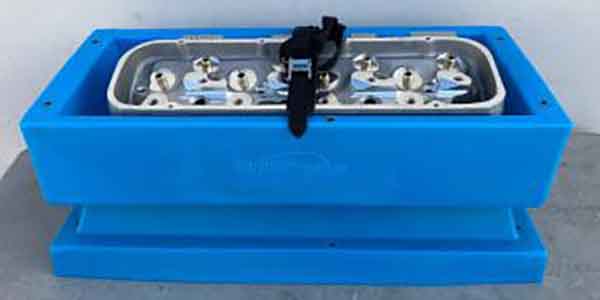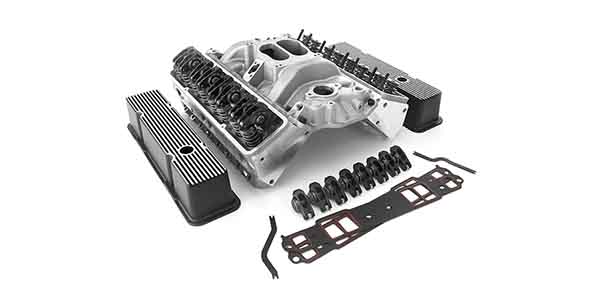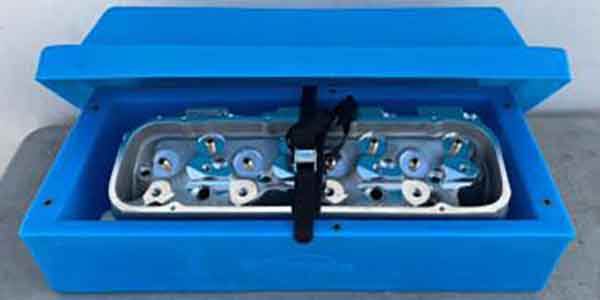Flow…that magical, mystical word that is seemingly carved in stone anytime the discussion topic turns to performance cylinder heads. Whether you are a seasoned veteran in the engine wars or finalizing the specs for your first ever build, it is virtually impossible to avoid it.
The flip side of that coin always carries another word attached to it – porting. We all know the “why” of port work (to achieve more usable power from the engine), but the “how” can be a completely different story. To illustrate that point let’s take a comparative look at two examples of domestic V-8 engines.
Let’s say engine number 1 is a restoration build of a 425 Buick Nailhead. Porting on this application would mostly consist of making sure the runners are equalized and any casting irregularities are addressed and some blending work of the bowl area to the valve seats in conjunction with a good quality valve job. These particular heads have physical limitations including very small valves and an exhaust port that has almost a 180-degree turn right behind the valve. Aside from port matching the manifold to the intake runners of the head, this would pretty much cover what’s needed to accommodate a pump gas, weekend toy that could be driven regularly to car shows or the local burger hangout.
For engine number 2 we’ll make a massive jump to the opposite end of the spectrum and look at a 762 cube Top Sportsman build. To start, the port work itself can be summed up in three letters: CNC (computer numerical control). This, of course, is being performed after extensive work on a flow bench has extracted all of the power enhancing capabilities that the head has to offer. After determining the final port configuration, it is digitized into the computer (along with the combustion chamber, valve bowls, etc.) and the tool paths are generated which allow the cylinder heads to be machined consistently to exact specifications even on multiple sets or high volume production runs. This obviously is not what we could consider an “apples to apples” comparison but it exemplifies the vast differences that can be associated with the term porting.
In today’s automotive industry either of these examples, and just about everything else in between, is readily available and can be purchased right off the shelf from a manufacturer, a distributor or a shop that specializes in application specific products. The goal then becomes to determine the best performing product that is available to achieve the power level and service life that is required for the particular build. It is at this point that we will more closely examine the physical aspects of a cylinder head that affect the flow characteristics.
OEM Modifications
We’ll begin at this point because these types of engines are being built on a daily basis all across the country for customers who are looking for a little more power but still want drivability and reliability operating on pump fuel. When your engine combo will be utilizing the original factory cylinder heads it is relatively easy to perform certain procedures that will reward you with not only additional power but also a more efficiently operating engine.
The one thing to keep in mind before starting to work on any area of the cylinder head though is that everything should be done with a realistic amount of restraint. There is that overwhelming desire in every hot rodder on the planet to see just how far we can push the envelope and this usually turns out to cause more harm than good when working with a street engine that will spend most of its life operating below 5,000 RPM.
Unless you are significantly increasing the actual displacement of the engine, there is no need to port the runners to a larger volume because this will decrease the velocity of the flow through that runner and affect throttle response. The size and shape of the intake port has a direct relation to the power curve and torque of the engine. The air/fuel mixture needs to move rapidly enough to keep it in suspension thereby providing the engine with its optimum fuel charge on each induction cycle.
Keep your focus on fine tuning specific areas. You can use a set of inside calipers to make sure the intake and exhaust runners are sized consistently, only removing material where needed in order to equalize them. Match the port openings to the gasket that will be used for final assembly and blend the openings into the runner. Smooth out any sharp edges on the short side radius of the runners but be careful not to drastically alter the angle because air already has a difficult time making the turn into the valve bowl and this situation gets even more pronounced as valve lift increases.
Depending upon the exact type of cylinder head you are using, you may or may not have sufficient material to do any smoothing or blending around the valve guide. If you are able to work in this area, keep your modifications consistent on each runner and be careful not to cut a trough around the guide in the bowl area as this will disrupt the flow on the long side turn.
The next step we will address is bowl blending. Take your time and work cautiously because the last thing you want to do is to have to replace a valve seat because of a slight slip with the die grinder. In many instances, this can be accomplished with a cartridge roll instead of using a carbide cutter. Remove any sharp edges and blend the bowl into the valve seat. Again, take your time in this area and make sure it is consistent and round.
At this point you will have eliminated irregularities in the casting and smoothed or blended any sharp edges that would have a negative effect on the flow pattern through the cylinder head. When cutting the seats for the valve job, make sure that all of the valves are at the same depth in the combustion chamber to keep the chamber volumes consistent and also to aid in keeping the valve stem heights consistent as well since this will directly affect the installed height of your valve springs.
The final step for the top end would be to port match the intake manifold to the runners of the cylinder heads. Do a mock up to check manifold fitment with the heads on the block using the same type of gasket that will be used for final assembly.
Aftermarket Cylinder Heads
When it comes to building a higher output engine utilizing aftermarket cylinder heads, we have more options today than ever before. There are a number of manufacturers that offer coverage for many applications which will enable you to design a combo that might not have been feasible in the past without being limited to modified factory heads. We also have modern designs available to us, examples such as the GM LS and Ford Modular heads, units that have been developed into some serious power producing components by the aftermarket.
So let’s discuss the prospect of making viable modifications to an aftermarket cylinder head. The manufacturers have spent literally millions of dollars in research and development to provide a product that can achieve pretty amazing results right out of the box. For example, it is relatively easy to build a 500+hp small block Chevy that requires no additional porting work other than possibly port matching the intake manifold to the cylinder heads. The point here is that in order to make improvements in many of these heads by porting on them would require you to have the means to test everything that is done.
Many aftermarket companies are very dedicated to producing a great product through extensive testing. They employ wet flow testing of their port designs which not only provides the actual flow numbers the head is making but allows them to see how the fuel charge is moving into the chamber area. Changes can be made to seat angles, valve shrouding, back cuts, etc. and then viewed to monitor the results.
When you couple this with the ability to measure swirl, tumble and other parameters, it is easy to see that any additional work that might be performed on the cylinder head could be detrimental without these extensive testing abilities to verify the results. That is not to say that it can’t be done because there are many shops across the country that turn out modified designs, particularly when it comes to full competition applications, but they are seasoned professionals who not only perform rigorous testing in the design stages but spend countless hours in the dyno room as well.
Another area that we will touch on is the actual finish in the runner itself. In an as-cast cylinder head, a certain amount of surface roughness will help keep the fuel charge suspended as it travels through the port providing a mixture that gives a more complete burn and making the most efficient use of the fuel once it enters the combustion chamber. In that same train of thought the finish of a cylinder head that has been CNC machined also has the same benefit on keeping the air/fuel mixture more consistent. In many applications if the runner were to be “polished” to a very smooth finish it could reduce this factor and lower the efficiency of the fuel charge.
There are many variables to consider when it comes to the design and finish of a cylinder head but by utilizing the information that is available from the aftermarket manufacturers or working closely with a professional shop that specializes in high performance applications can net you the results you’re after without having to go through a trial and error process.
Choosing a Cylinder Head
When choosing a cylinder head for your engine build there are points to consider which will ensure that you will have a combination that meets the power output you’re looking to achieve and work well in the RPM range where the engine will spend most of its time. As we discussed earlier, port velocity is very important and matching the correct runner size to the displacement of the engine will also be a factor at the top of the list.
One of the things that I have advised customers to do is to view the cylinder head as a component of the overall package, which it actually is, instead of looking at it as a stand alone item. Many times the cylinder head will be the first item to be decided upon and the remainder of the engine will be built around it. Working from that aspect is fine if you already have a set of heads that are usable for the application but it can lead you into the prospect of having to make compromises in other areas of the build which might not be the optimum choice for your combination.
One of the calculations that you can use to help determine the best fit for the engine is to figure your intake valve diameter size-to-bore ratio. If you’re using a wedge-type head, you want to be around 50 to 51% of the bore size, whereas if you are using a canted valve head, it will be 52 to 53% of the bore size. As an example we’ll use an engine that has a 4.125˝ cylinder diameter and utilizing wedge design heads. It would be calculated as;
4.125˝ x 50% = 2.0625˝
If we figure at 51% it is;
4.125˝ x 51% = 2.1037˝
There are readily available valves sized from 2.055˝ to 2.100˝ which could be used in this application and be within the range we are looking for.
Another area that you can figure for your combination is the CFM demand of the engine at maximum piston speed. To determine that number we multiply the displacement by the RPM and .000978474 and divide that by the number of cylinders. If we have a 400 cubic inch, V8 engine that will achieve 6,000 RPM it would calculate as;
400 x 6000 x .000978474 divided by 8 = 293.5
So a cylinder head that is capable of flowing 294 CFM at maximum valve lift should meet the requirements of this engine. There are other factors to consider like runner volume, combustion chamber size, intake manifold type, etc. but all of these will be dependent upon other variables such as whether the engine will be an over square or under square design, type of fuel that will be used, weight of the vehicle and whether or not it will be a naturally aspirated or forced induction build.
Everything we’ve discussed is in somewhat generalized terms but hopefully this will help you to fine tune the physical aspects of your next engine build in regard to the cylinder heads.
Highly specialized builds or extreme competition applications will have some different considerations in the overall design but if you take your time, do your research and select your components accordingly, it will all correlate into a final product that will enable you to achieve the power output you are looking for and give you a big smile when you stand on the accelerator pedal…which is just what every hot rodder wants! ν









